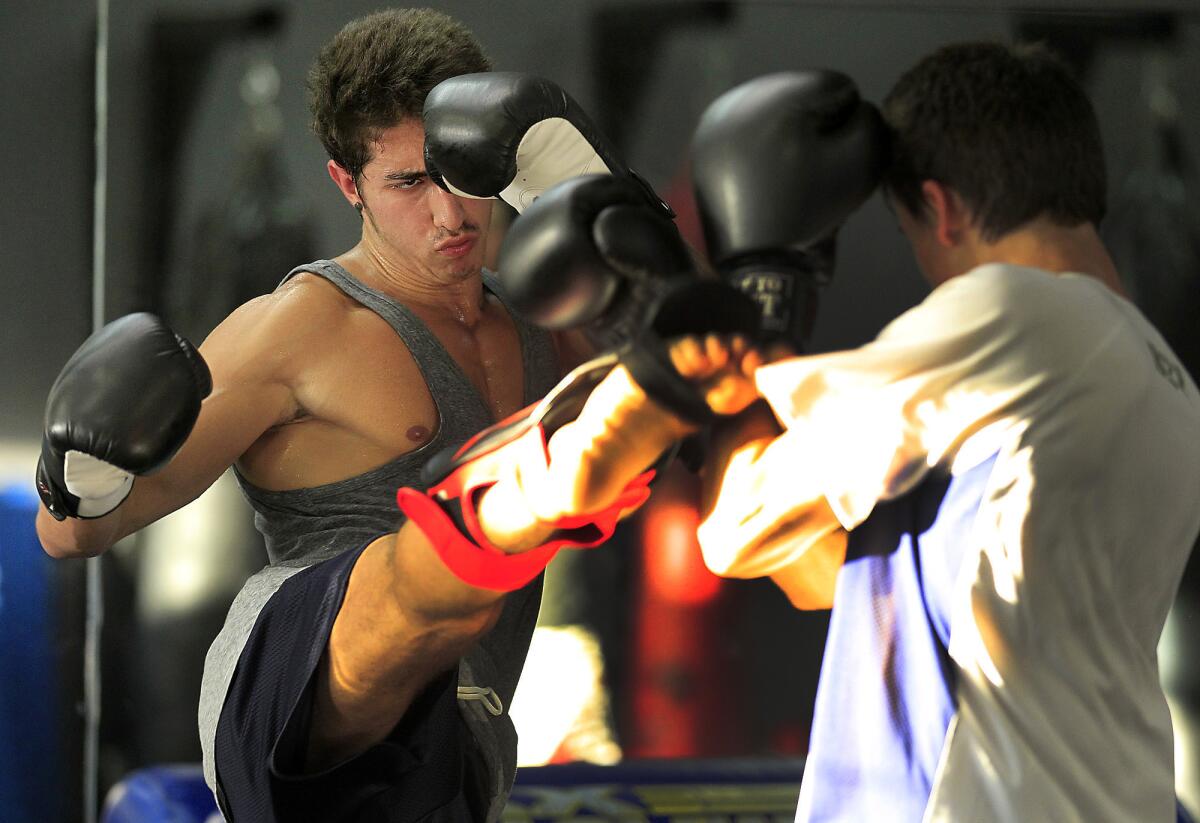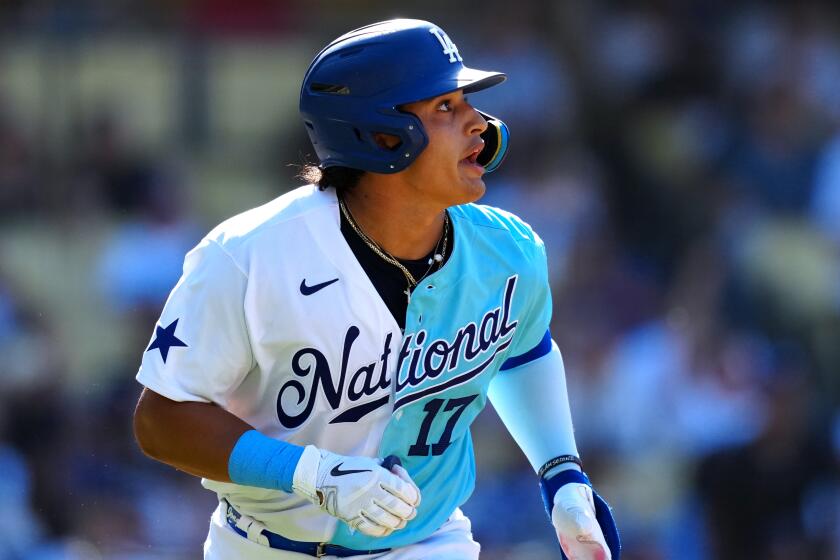Mixed martial arts looks to Southern California hotbed

Mike Low, a mixed martial arts matchmaker, remembers when he had trouble finding enough talent for his local fight cards. Not anymore.
“Four years ago, I’d have to look for fighters, gym to gym. Now I get 50 emails a day from people pitching their fighters from here. And they’re usually pretty good fighters,” he said.
The Ultimate Fighting Championship has taken hold across the country and the sport’s boom has spawned about a dozen second-tier MMA pro circuits in Southern California. Hundreds of prospects are trying to battle their way through the octagon, hoping to land a UFC contract.
“Without a doubt, we are the hotbed of the country” in MMA talent, said Low, live events manager and matchmaker for the King of the Cage circuit. He typically stacks his five annual fight cards at San Manuel casino in Highland with local fighters, and the bouts draw about 4,000 fans.
Low said that MMA — not boxing — is the combat sport of choice for young athletes who are schooled in wrestling, striking, jiujitsu, karate, kickboxing and other skills. “I’m not going to say boxing is a dying sport, but it’s steadily losing its popularity and MMA has overtaken it,” he said.
MMA-specific gyms dot the landscape, from Santa Monica to Rosemead, Rancho Cucamonga to San Diego, serving as the training home of champions and contenders and for those amateurs looking to shed 20 pounds.
One prospect is 25-year-old James Moontasri, who is 4-0 as a welterweight. He currently fights for a Southern California-based MMA organization known as Resurrection Fighting Alliance (RFA) and is on their fight card scheduled for August in Carson.
He converted to MMA after winning a taekwondo silver medal at the 2007 Pan American Games. Moontasri works as a trainer at the UFC Gym in Torrance and is hoping three more victories this year will launch him to the UFC.
Moontasri trains at Black House MMA Gym in Gardena, a converted warehouse, where a couple of dozen pros work out. The group includes UFC middleweight champion Anderson Silva and former light-heavyweight champions Lyoto Machida and Antonio Rodrigo Nogueira.
“To train and spar alongside Anderson and Lyoto is like going to Disneyland,” Moontasri said. “If you keep doing the right things — train hard, hang around the right guys —- good things will happen. You’re humbled every day in there. It’s all about keeping your eyes on the prize.”
One could argue MMA was born here, because the South Bay is home to the famed Brazilian Gracie family, whose Royce employed his multi-discipline skills to win the first Ultimate Fighting Championship event. More than a dozen years later, the Southland is spinning out young champions such as the UFC’s first women’s belt-wearer, Ronda Rousey of Venice.
“Southern California has always been a huge market for the UFC and the sport of mixed martial arts,” UFC President Dana White said. “We’ve seen a lot of our top stars come from Southern California.”
Another local young fighter on the rise is King of the Cage welterweight champion David Gomez, 30, of Rancho Cucamonga.
Gomez has a pro record of 15-6-1, and his Aug. 29 fight is a rematch with the man from whom he took the belt, Joshua Alves. Gomez’s purse could surpass $10,000, a significant barrier in his fourth year in the circuit.
“If you want to nail it, you have to work at this sport six days a week,” he said.
Starting pay isn’t the motivation, though. Some young, unbeaten fighters who spoke to The Times said they were five fights into their career before they were paid $1,000 for a bout. And some smaller organizations pay their fighters a percentage of ticket sales — a benefit of booking a Southern Californian prospect who can draw fans.
The real pot of gold for young fighters is an entry-level UFC contract, which varies according to the company. A manager familiar with contract negotiations said UFC fighters typically get about $8,000 for their first fight, plus another $8,000 if they win.
UFC has about 250 fighters under contract, and it’s a tough business. UFC has a “cut” stipulation in most contracts, meaning they can release a fighter at any time.
But the young talent keeps coming.
King of the Cage amateur champion Justin Williams, 22, of Lucerne Valley, hopes to turn pro this year after a few more bouts.
Williams has seen and trained with the talent in local gyms. “I just go and roll with the guys, and it’s made a big difference in me becoming a better fighter,” he said.
The volume of fighters has led to improved training, intensifying the athletes’ push to make their skills more sophisticated.
“If you’re thinking about doing this for a living, this is the place to be when you consider the talent pool, the quality of coaching,” said Ed Soares, who manages Silva and Machida, and owns the RFA fight company.
“Think of yourself as a fighter in Black House. You’re sizing yourself up and get a chance to stand across from [Silva], the greatest fighter in the world,” Soares said. “Imagine the confidence, the bounce in the step that kid has when it’s time to step into the ring for his actual fight.”
UFC has about 35 pro fighters with Southern California ties, including bantamweight champion Dominick Cruz (19-1) of El Cajon.
Cruz, 28, won the World Extreme Cagefighting bantamweight belt in 2010 before the UFC folded the WEC roster into its organization. Cruz later defeated Urijah Faber and Demetrious Johnson during his four title defenses.
Meanwhile, he has also invested in two Alliance Training Center gyms in San Diego. Cruz often feels as if he’s kindred spirits with aspiring fighters who sign up at his gym.
“As someone who worked 9-to-5 jobs as a landscaper, paint mixer, telemarketer, in masonry and at McDonald’s until I first fought for a world title in 2010, I generate my power and fighting drive from working those jobs,” Cruz said.
“Every time I wake up and don’t want to train, I think of how much I don’t want to throw those rocks out of the tractor into the pit again, and how much I’ve enjoyed fighting in front of a million people [on television]. I understand what makes people love to compete.”
More to Read
Go beyond the scoreboard
Get the latest on L.A.'s teams in the daily Sports Report newsletter.
You may occasionally receive promotional content from the Los Angeles Times.











